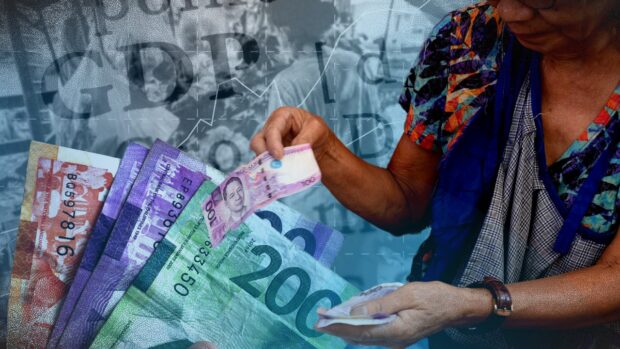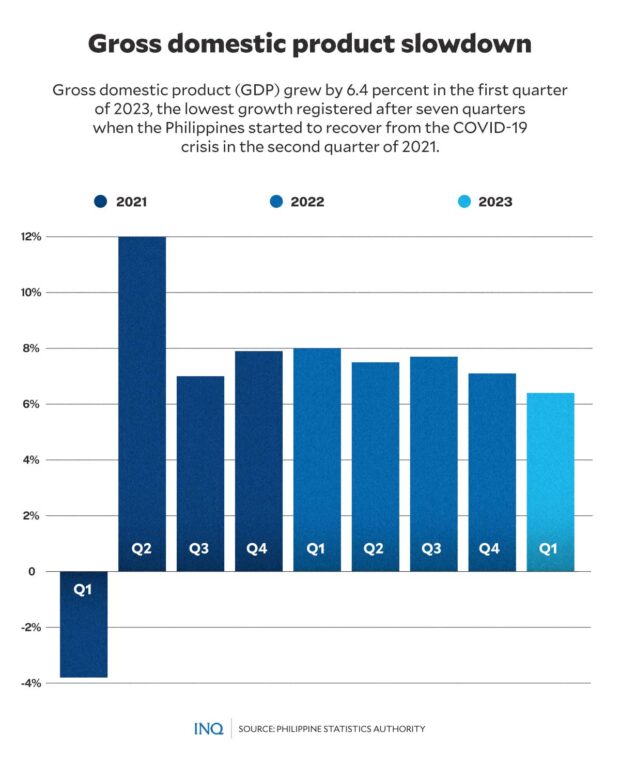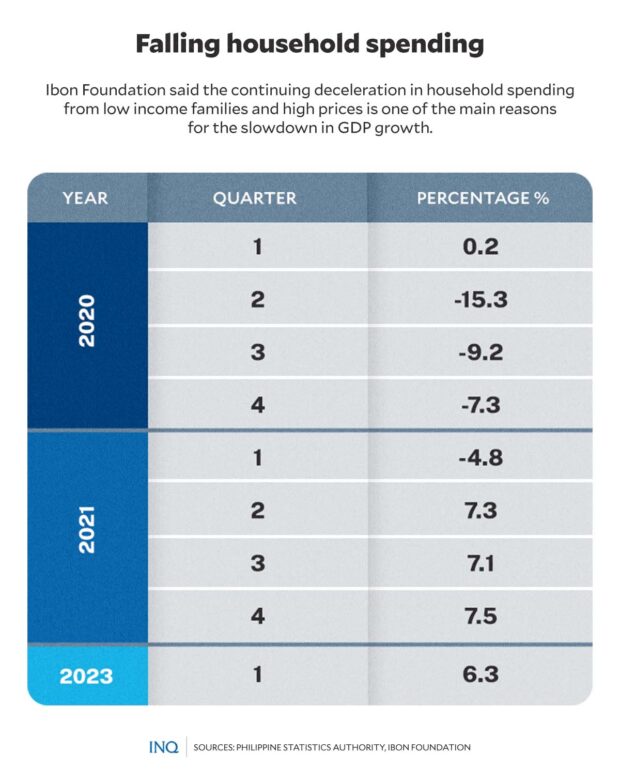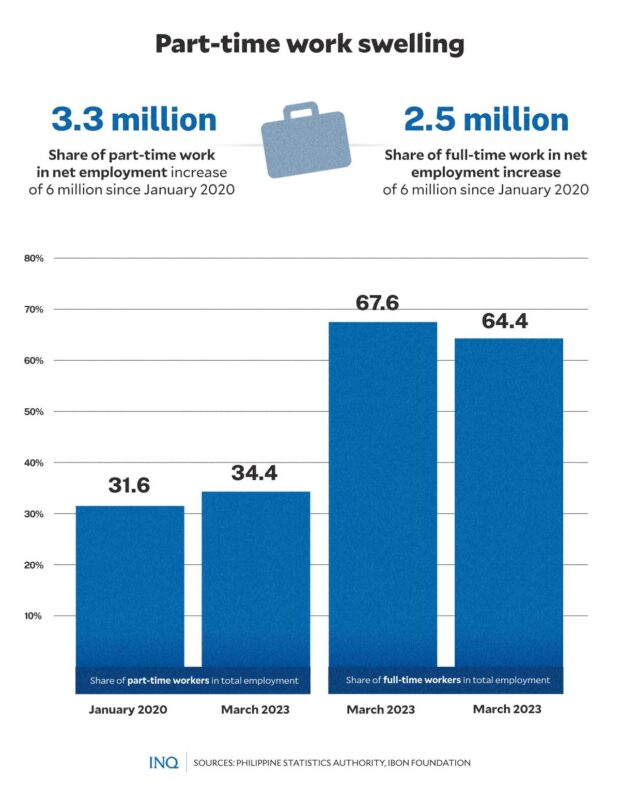Gov’t fix sought as household spending continues slide, GDP growth slowest in 7 quarters

COMPOSITE IMAGE: JEROME CRISTOBAL FROM INQ FILE PHOTOS
MANILA, Philippines—The Philippine gross domestic product (GDP) grew at its slowest pace since the second quarter of 2021 and, as stressed by a think tank, one of the main reasons for the slowdown of GDP growth is the “continuing deceleration in household spending.”
Last Thursday (May 11), the Philippine Statistics Authority (PSA) said GDP grew by 6.4 percent in the first quarter of 2023. This, however, was slower than the 7.1 percent in the last quarter of 2022 and 8 percent in the first quarter of 2022.

GRAPHIC Ed Lustan
READ: Philippines’ GDP growth above-target at 6.4% in Q1 2023
But while the latest readout is better than analysts’ median forecast of 6.2 percent, the think tank Ibon Foundation said the slowdown “underscores the urgency of boosting demand and the economy’s supply response to spur inclusive growth.”
It explained that measured by expenditure, Household Final Consumption Expenditure (HFCE) accounts for over 70 percent of GDP, but in the first quarter of 2023, household spending fell to 6.3 percent.

GRAPHIC Ed Lustan
The think tank pointed out that HFCE has been declining for four consecutive quarters and that the 6.3 percent is already 3.7 percentage points slower than the 10 percent in the first quarter of 2022.
Article continues after this advertisementAs it stressed, this is an issue that the government can immediately address.
Article continues after this advertisementHousehold income, spending falling
Ibon Foundation said “this is a clear sign that the purchasing power of families is failing from soaring prices, low wages and earnings, and worsening informality and joblessness.”
The think tank stated that while inflation eased to 6.6 percent in April from 7.6 percent in March, it was still the highest in Southeast Asia, based on countries’ national statistical agencies this year.
RELATED STORY: Giving up some needs: How the poor deal with high inflation
As explained by the PSA, the ease in inflation was attributed to the slower increase in the prices of food and non-alcoholic beverages, transportation, and housing, water, electricity and gas.
However, as Ibon Foundation pointed out, the readout was still higher than Singapore’s 5.5 percent, Indonesia’s 4.3 percent, Malaysia’s 3.4 percent, Vietnam’s 2.8 percent, and Brunei Darrusalam’s 1.2 percent.
Likewise, the minimum wage Filipino workers receive is not even above the poverty threshold, which the think tank said already “grossly underestimates” poverty in the Philippines.
The poverty threshold in 2021, which is the minimum income that a family of five needs to meet basic food and non-food requirements, was P12,030, or almost P80 a day for every family member.
READ: Basic wage in PH not even enough to meet poverty threshold, says think tank
However, based on data from the National Wages and Productivity Commission, the average monthly minimum wage in the Philippines is only P8,902, which is P3,128 or 26 percent less than the already low poverty threshold.

GRAPHIC Ed Lustan
Then as to employment picture, Ibon Foundation said 3.3 million of the net employment increase of 6 million since January 2020 is part-time work, while only 2.5 million of the increased employment was full-time work.
RELATED STORY: Dark side of PH jobs numbers: More Filipinos in outright informal work
As it stressed, part-time work, which is less than 40 hours a week is “usually work with low pay and no benefits.” From January 2020 to March 2023, the share of part-time workers in total employment increased from 3.16 percent to 34.4 percent.

GRAPHIC Ed Lustan
RELATED STORY: ‘Disconnected from reality’: Gov’t told to present more honest labor numbers
Gov’t ‘optimistic’ about GDP growth
Despite these, however, with the 6.3 percent GDP growth in the first quarter of 2023, Budget Secretary Amenah Pangandaman highlighted the Philippines’ “current dynamic domestic economy and positive outlook.”
“The country now has a dynamic domestic economy. This means that even if the regional and global economic environment would worsen, ours has its own momentum and own dynamism to sustain growth,” Pangandaman said.
She said “this quarter’s GDP performance indicates that the Philippines is returning to its high growth trajectory,” stressing that the readout is “well within the government’s target of 6 percent to 7 percent for 2023.”
This, as she shared: Based on latest data from countries that have released their first quarter 2023 real GDP growth, the Philippines grew the fastest compared to other emerging economies in the region.
“I think we are doing better. With all these data coming in, I can say that the Philippines’ 6.4 percent is actually outstanding. It would be excellent if it reached 7 percent, but 6.4 percent, or even 6 percent, is already outstanding,” she said.
“So, we now project 6.6 to 7.5 percent growth from the second quarter to the fourth quarter of 2023, and [a] full-year GDP growth target of about 7.1 percent,” Pangandaman added.
She also expressed confidence that the country will reach its growth projection, which remains at 6.5 to 8 percent for 2024 to 2028, “amid various risks posed by geopolitical and trade tensions, possible global economic slowdown, and weather disturbances in the country.”
Filipinos need help
As Pangandaman said, “rest assured that the administration […] remains committed to implementing priority programs and strategies in line with our 8-point Socioeconomic Agenda and the Philippine Development Plan 2023 to 2023.”
This, as “to attain an inclusive and sustainable growth for our country, and the Filipino people.”
But for Ibon Foundation, the slowdown in GDP growth because of decelerating household spending “highlights the urgency of substantial wage hikes and emergency cash assistance.”
The think tank pointed out that these will “increase household consumption and welfare, which will at the same time boost aggregate demand as an engine of [economic] growth.”
It also warned against the government’s “misplaced reliance on exports and foreign investment as sources of growth as the global economy weakens and the likelihood of a global recession increases.”
“Boosting aggregate demand with wage hikes and ayuda needs to be accompanied by measures to improve the economy’s supply response, lest this just add to inflationary pressures,” it said.
It pointed out that the country and its farmers are already gearing up for the effects of El Niño, which will certainly affect productivity in the agricultural sector unless the government intervenes immediately and effectively.
“The P5.3 trillion national budget for 2023 can be wielded better to spur growth and spread its benefits better,” it said, stressing that “spending needs to be shifted away from capital-intensive import-dependent infrastructure spending, addressing corruption and pork barrel leakages, and containing bloating debt servicing.”